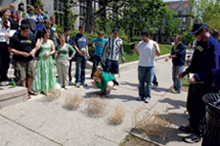Eye on the Quads
The Searchers
Fourth-year student David Franklin documents the habits and rituals of Chicago Scavengers.
When David Franklin became an assistant resident head at the Snell-Hitchcock dormitory in fall 2006, he immediately recognized the advantages of his position. Not only was he serving as an authority figure to his fellow students, he was also poised to advance his skills as a filmmaker.
“I’ve been studying film my whole time here,” he says, “and I’ve been in Fire Escape Films [a student filmmaking organization] since my first year, so I’ve made a few movies and helped out with a few movies.”
Having completed several short fiction films and music videos, Franklin felt well prepared to assume greater challenges. He set his sights on completing his first feature-length documentary, a comprehensive look at Scav Hunt 2007 with the working title Scavengers.
Scav Hunt is an annual College tradition that dates back to 1987. It started as a traditional scavenger hunt, complete with a list of 216 ordinary items, but it has since expanded into an epic four-day event that challenges students to complete road trip objectives, construct outrageous creations, and compete in athletic contests, among other exploits. It was previously captured on film in a 2003 documentary, The Hunt, made by Sean T. Daily, AB’02, and Christopher R. Plotner, AB’00.
Franklin was well versed on Scav Hunt, having competed in 2005 and 2006 as a resident of Max Palevsky Residential Commons. Now opposing his former team as a Snell-Hitchcock resident, he decided to maintain neutrality by shooting footage of all the participants, as well as the judges who prepare Scav Hunt’s list of approximately 300 items.
“I had the necessary resources and contacts,” Franklin says. “I knew people who could help me make it, and then I just seemed to be in a unique position to get it done.” With a crew of eight assembled, Franklin led the charge, recording approximately 15–20 hours of footage throughout Scav Hunt’s preliminary stages. He interviewed team captains and judges, and was on hand for each team’s fundraising events and ceremonies. “The Snell-Hitchcock team does a service auction,” he says. “People would offer random skills... one guy had access to a cool place in one of the anatomy buildings, so he offered a tour for people to go and see.”
Franklin’s greatest workload, however, was compiling as much footage throughout the actual Scav Hunt 2007 event as possible, and that’s when he deployed his team of assistants. He also equipped each road trip team with a digital camera. “People don’t get to see the road trip happen,” Franklin says, “so I asked them [the road trip participants] to film themselves as they were screwing around in the car.”
All told, Franklin ended up with a total of 110 hours of footage, which he condensed to 50 hours of usable material. He continued to pare that down into a two-hour film, which he hoped would debut at Doc Films by the time of Scav Hunt 2008. Franklin says, “I didn’t realize how long it takes to edit a documentary. Unless you’re working full time eight hours a day, you can’t get it done quickly. It’s hard to find huge chunks of time to work, because I have to sleep at some point. But I just find time where I can, and so far that’s worked out.”
Franklin’s fellow filmmakers have been generous with feedback, and he has also sought the advice of some of his subjects. “From my vantage point, it seems he is producing a film more on the blood, sweat, and tears of the Hunt as opposed to its whos, whats, and wheres, and that certainly is valuable,” says Jim Ryan, Scav Hunt’s head judge.
Regardless of what remains in the final cut, Franklin is pleased to have created a record of such an important College tradition. His hope is that Scavengers will “immortalize Scav Hunt more than Scav Hunt’s already immortalized itself.”—Jenny Seay

